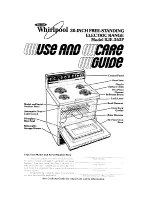
Causes of damage
en
7
]
Causes of damage
Causes of damage
Hob
Caution!
■
Only use the burners when cookware has been
placed on top. Do not heat up empty pots or pans.
The saucepan base will be damaged.
■
Only use pots and pans with an even base.
■
Place the pot or pan centrally over the burner. This
will optimise transfer of the heat from the burner
flame to the pot or ban base. The handle does not
become damaged, and greater energy savings are
guaranteed.
■
Clear up spills immediately. Use deep pots for
dishes with a lot of liquid. This will prevent the food
from boiling over.
■
Do not use roasting dishes if they must be heated
using two burners. This will cause heat
accumulation. The appliance could be damaged.
■
Cooking on gas burners releases extra heat and
moisture. Adjacent units may become damaged over
time. For long cooking times, switch on the cooker
hood or ventilate the room.
■
Observe the manufacturer's instructions when using
special ovenware.Aluminium foil and plastic
containers can melt and stick on hot burners.
■
Ensure that the gas burners are clean and dry. The
burner cup and burner cap must be positioned
exactly.
■
Ensure that the top cover is not closed when the
oven is started up.
Damage to the oven
Caution!
■
Accessories, foil, greaseproof paper or ovenware on
the cooking compartment floor: do not place
accessories on the cooking compartment floor. Do
not cover the cooking compartment floor with any
sort of foil or greaseproof paper. Do not place
ovenware on the cooking compartment floor if a
temperature of over 50 ºC has been set. This will
cause heat to accumulate. The baking and roasting
times will no longer be correct and the enamel will
be damaged.
■
Water in a hot cooking compartment: do not pour
water into the cooking compartment when it is hot.
This will cause steam. The temperature change can
cause damage to the enamel.
■
Moist food: do not store moist food in the cooking
compartment when it is closed for prolonged
periods This will damage the enamel.
■
Fruit juice: when baking particularly juicy fruit pies,
do not pack the baking tray too generously. Fruit
juice dripping from the baking tray leaves stains that
cannot be removed. If possible, use the deeper
universal pan.
■
Cooling with the appliance door open: only allow the
cooking compartment to cool when it is closed. Even
if the appliance door is only open a little, front panels
of adjacent units could be damaged over time.
■
Very dirty door seal: If the door seal is very dirty, the
appliance door will no longer close properly when
the appliance is in use. The fronts of adjacent units
could be damaged.Always keep the door seal clean.
■
Appliance door as a seat, shelf or worktop: Do not
sit on the appliance door, or place or hang anything
on it. Do not place any cookware or accessories on
the appliance door.
■
Inserting accessories: depending on the appliance
model, accessories can scratch the door panel
when closing the appliance door. Always insert the
accessories into the cooking compartment as far as
they will go.
■
Carrying the appliance: do not carry or hold the
appliance by the door handle. The door handle
cannot support the weight of the appliance and
could break.
■
Heavy accessories: do not pull out heavily laden
accessories too far without first unloading them
sufficiently. Heavy accessories will tip when pulled
out. This causes pressure to be exerted on the shelf
supports in the cooking compartment, which can
damage the enamel. Relieve the strain on the
accessories when they are pulled out by raising
them slightly with one hand. Caution: always use an
oven cloth or oven gloves when handling hot
accessories.
Storage compartment
Caution!
Do not place hot objects in the storage compartment. It
could be damaged.
Summary of Contents for HGJ9A8Q50I
Page 1: ... en Instruction manual Free standing cooker HGJ9A8Q50I ...
Page 2: ......
Page 23: ...6 ...








































